From Verona To Valpolicella
 The Valpolicella area takes in huge swathe of territory to the north-west of Verona. The countryside is completely hill-based, with gentle slopes and streams, planted with vineyards almost everywhere, trained either in pergolas or on high wires. The discovery route for the great wines of this region begins right in the city of Verona and branches out in two directions. The first route goes directly north following the course of the river Pantena. Valpantena, in fact, is the name of a specific type of wine. The second route leaves Verona for Valpolicella following the course of the Adige river before going up into the hills.
The Valpolicella area takes in huge swathe of territory to the north-west of Verona. The countryside is completely hill-based, with gentle slopes and streams, planted with vineyards almost everywhere, trained either in pergolas or on high wires. The discovery route for the great wines of this region begins right in the city of Verona and branches out in two directions. The first route goes directly north following the course of the river Pantena. Valpantena, in fact, is the name of a specific type of wine. The second route leaves Verona for Valpolicella following the course of the Adige river before going up into the hills.
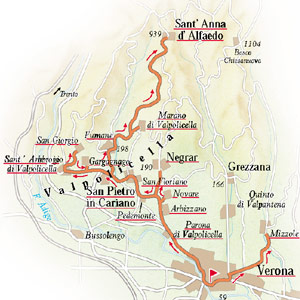
Verona
It is not difficult to distinguish between the Verona of history, first Roman and then medieval, which elegantly unfolds between the two curves of the Adige river in a splendid position between the plain and high ground, and modern Verona, the city of production and industry, which has sprung up around it and spread outwards towards the many towns in the province. Historically Verona is the city of love celebrated by the poet Catullus and by Shakespeare, but it is also a crossroads on the way to the Tyrol and the Teutonic world, and the place where Lombardy and Veneto meet. The image of old Verona is still there in the remarkable Arena and Roman Theatre, although the strongest imprint on the city is that left by the rule of the Della Scala family, known as the Scaligeri, who inspired here one of the most significant periods of the Renaissance. This is the Verona of the Scaliger Tombs (Arche Scaligere) and of the Old Castle (Castelvecchio), of the Town Hall (Palazzo della Ragione or del Comune) and the Loggia del Consiglio. The history of those centuries is a long and complicated one, which saw many changes here. The subsequent dominion of Venice led to a time of great prosperity which produced the greatest works of art and made it possible to finish building the fabric of the many magnificent churches in the city; by revealing to the visitor the different stages in their construction, they provide an incomparable proof of just how alive art was in Verona. So it was that churches like the Duomo or the Church of Sant’ Anastasia were effectively turned into priceless treasuries brimming over with works of art.
Arena
 With its 25,000 places, taken up every year in July and August by audiences coming to its famous performances of opera, the Arena symbolises Verona. The original amphitheatre was built in the 1st c. outside the walls and was also used for what were known as naumachie, the Greek word for naval battles. To ‘stage’ these, the whole ground floor of the auditorium would be flooded with water piped from the Adige river along a complex network of conduits. Only a few metres of the amphitheatre’s outer arcade wall have survived, whereas the inner arcade, which was built with two rows of arches, still stands intact. The external structure of the arena is dry-built of limestone blocks from the Valpolicella district which link walls of bricks and stones. The auditorium nowadays has 44 rows on steps which are not the same as the originals, and access is by way of 64 entrances. The stage is in the shape of an ellipse.
With its 25,000 places, taken up every year in July and August by audiences coming to its famous performances of opera, the Arena symbolises Verona. The original amphitheatre was built in the 1st c. outside the walls and was also used for what were known as naumachie, the Greek word for naval battles. To ‘stage’ these, the whole ground floor of the auditorium would be flooded with water piped from the Adige river along a complex network of conduits. Only a few metres of the amphitheatre’s outer arcade wall have survived, whereas the inner arcade, which was built with two rows of arches, still stands intact. The external structure of the arena is dry-built of limestone blocks from the Valpolicella district which link walls of bricks and stones. The auditorium nowadays has 44 rows on steps which are not the same as the originals, and access is by way of 64 entrances. The stage is in the shape of an ellipse.
Duomo
 Its location is in the medieval part of the city where the bend in the Adige river is tighter. It was built on the ruins of the Christian churches destroyed in the earthquake of 1117. A prolonged programme of renovation, begun in 1444, meant that by 1606 the building had taken on a Renaissance look. The apse, built of tufa, and the foundations are Romanesque, while, inside, the cross-vault is supported on Gothic columns. The facade retains its Romanesque design, enhanced by double lancet windows, pilaster strips and small arches, and the central part features a large prothyrum on two levels. Inside, the presbytery is surrounded by a marble choir-screen by Sanmicheli, with a tall base supporting Ionic columns. Beneath the organ is a short flight of steps leading to a vestibule which consists of three small naves and contains a priceless octagonal cut from a single block of marble in the 12th c.
Its location is in the medieval part of the city where the bend in the Adige river is tighter. It was built on the ruins of the Christian churches destroyed in the earthquake of 1117. A prolonged programme of renovation, begun in 1444, meant that by 1606 the building had taken on a Renaissance look. The apse, built of tufa, and the foundations are Romanesque, while, inside, the cross-vault is supported on Gothic columns. The facade retains its Romanesque design, enhanced by double lancet windows, pilaster strips and small arches, and the central part features a large prothyrum on two levels. Inside, the presbytery is surrounded by a marble choir-screen by Sanmicheli, with a tall base supporting Ionic columns. Beneath the organ is a short flight of steps leading to a vestibule which consists of three small naves and contains a priceless octagonal cut from a single block of marble in the 12th c.
Palazzo del Comune o della Ragione
 One side of the Town Hall looks out on Piazza delle Erbe and the other on Piazza dei Signori. This palace was built at the end of the 12th c. to a square ground-plan, with a courtyard which has a tower at each corner. The facade, which is a combination of tufa and brick, was altered in the 16th c. in order to add to it the figure of the Venetian lion of St Mark. It is surmounted by a row of small arches and these feature three-mullioned windows as does the courtyard. Here, enclosed by a round-arched portico, the corn market used to be held. The highest tower, the Lamberti tower, which had existed previously and was completed at the end of the 15th c., still houses the two bells which were rung to summon the council to assembly or in case of fire.
One side of the Town Hall looks out on Piazza delle Erbe and the other on Piazza dei Signori. This palace was built at the end of the 12th c. to a square ground-plan, with a courtyard which has a tower at each corner. The facade, which is a combination of tufa and brick, was altered in the 16th c. in order to add to it the figure of the Venetian lion of St Mark. It is surmounted by a row of small arches and these feature three-mullioned windows as does the courtyard. Here, enclosed by a round-arched portico, the corn market used to be held. The highest tower, the Lamberti tower, which had existed previously and was completed at the end of the 15th c., still houses the two bells which were rung to summon the council to assembly or in case of fire.
San Bernardino
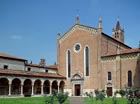 The 15th c. church is entered through a cloister which opens up onto the brick facade with triangular pediment, flanked by Gothic pinnacles and adorned with a Renaissance doorway. The interior is embellished with frescos and decorations dating from the time it was built, including the Pellegrini Chapel, another example of Renaissance architecture by Michele Sanmicheli who on this occasion used a circular plan with recesses and niches. The former library, now known as the Sala Morone after the artists who decorated it, contains examples of painting from the late 15th c. to the early 16th c. on subjects associated with the Franciscans who commissioned the church.
The 15th c. church is entered through a cloister which opens up onto the brick facade with triangular pediment, flanked by Gothic pinnacles and adorned with a Renaissance doorway. The interior is embellished with frescos and decorations dating from the time it was built, including the Pellegrini Chapel, another example of Renaissance architecture by Michele Sanmicheli who on this occasion used a circular plan with recesses and niches. The former library, now known as the Sala Morone after the artists who decorated it, contains examples of painting from the late 15th c. to the early 16th c. on subjects associated with the Franciscans who commissioned the church.
San Fermo Maggiore
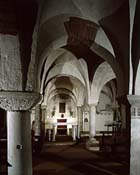 The church, which comprises two buildings one on top of the other, was part of a Benedictine and then a Franciscan monastery. The lower one was begun in 1065 using Romanesque styles, together with the upper, which was, however, altered in the 15th c. and assumed Gothic features. The higher part of the facade is occupied by four very tall windows. The main apse is surrounded by small Romanesque apses and is lined with tall Gothic windows. The upper church has a 14th-c. wood ceiling, painted with figures of Saints, above a single nave. There are a number of tombs along the side walls. The frescoed presbytery has a 16th-c. choir-screen. The lower church has three naves supported on cruciform columns which, like the walls, are decorated with 11th and 13th c. frescoes.
The church, which comprises two buildings one on top of the other, was part of a Benedictine and then a Franciscan monastery. The lower one was begun in 1065 using Romanesque styles, together with the upper, which was, however, altered in the 15th c. and assumed Gothic features. The higher part of the facade is occupied by four very tall windows. The main apse is surrounded by small Romanesque apses and is lined with tall Gothic windows. The upper church has a 14th-c. wood ceiling, painted with figures of Saints, above a single nave. There are a number of tombs along the side walls. The frescoed presbytery has a 16th-c. choir-screen. The lower church has three naves supported on cruciform columns which, like the walls, are decorated with 11th and 13th c. frescoes.
San Zeno Maggiore
 First built outside the walls and destroyed by the earthquake in 1117, this sizeable church was re-built in the years that followed. The tufa facade is divided by a portico of double lancet windows in red marble and contains a large rose-window. The 12th-c. porch, supported on two marble lions, is sculpted and elaborate. The doors themselves have 24 wooden panels depicting stories from the New and Old Testaments. Several steps lead down into the interior, which is very spacious: a distinctive feature here is the re-use of a range of Roman material, including the Corinthian columns. In the presbytery, with its Gothic lines, is the triptych by Andrea Mantegna which portrays the Virgin Mary and Child in the company of angels and saints and is one of the key works of the Italian Renaissance. On the north side of the church is a Romanesque cloister containing paintings and tombs.
First built outside the walls and destroyed by the earthquake in 1117, this sizeable church was re-built in the years that followed. The tufa facade is divided by a portico of double lancet windows in red marble and contains a large rose-window. The 12th-c. porch, supported on two marble lions, is sculpted and elaborate. The doors themselves have 24 wooden panels depicting stories from the New and Old Testaments. Several steps lead down into the interior, which is very spacious: a distinctive feature here is the re-use of a range of Roman material, including the Corinthian columns. In the presbytery, with its Gothic lines, is the triptych by Andrea Mantegna which portrays the Virgin Mary and Child in the company of angels and saints and is one of the key works of the Italian Renaissance. On the north side of the church is a Romanesque cloister containing paintings and tombs.
Santa Maria in Organo
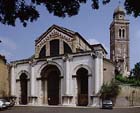 The outside appearance of this church gives a very misleading idea of its date, suggesting it was built between the 15th and 16th c. In reality the first stone was laid in the 8th c., another case of a church built for the Benedictines. At the end of the 15th c., the old church was rebuilt and given its present appearance by Michele Sanmicheli, who was inspired by the Temple of Malatesta in Rimini in his ‘modernisation’ of the old facade. The lower part of the facade is covered in marble and decorated with three arches, while the upper part is that of the old church, in brick and tufa stone with small pendentive arches. The panels at the back of the chancel are decorated with remarkable representations of architectural views and still lives by Fra Giovanni da Verona.
The outside appearance of this church gives a very misleading idea of its date, suggesting it was built between the 15th and 16th c. In reality the first stone was laid in the 8th c., another case of a church built for the Benedictines. At the end of the 15th c., the old church was rebuilt and given its present appearance by Michele Sanmicheli, who was inspired by the Temple of Malatesta in Rimini in his ‘modernisation’ of the old facade. The lower part of the facade is covered in marble and decorated with three arches, while the upper part is that of the old church, in brick and tufa stone with small pendentive arches. The panels at the back of the chancel are decorated with remarkable representations of architectural views and still lives by Fra Giovanni da Verona.
Piazza dei Signori
 The Piazza dei Signori is bounded by the Domus Nova, built in 17th c. Venetian style; the Renaissance Loggia del Consiglio, embellished with statues on the top cornice, by Alberto da Milano; the Palazzo della Ragione, built in the Middle Ages, and later modified; and the palazzo degli Scaligeri, lords of Verona from 1260 to 1387, famous for their hospitality to Dante whose statue stands in the centre of the piazza.
The Piazza dei Signori is bounded by the Domus Nova, built in 17th c. Venetian style; the Renaissance Loggia del Consiglio, embellished with statues on the top cornice, by Alberto da Milano; the Palazzo della Ragione, built in the Middle Ages, and later modified; and the palazzo degli Scaligeri, lords of Verona from 1260 to 1387, famous for their hospitality to Dante whose statue stands in the centre of the piazza.
Casa di Giulietta
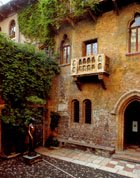 A short distance to the south-east of the Piazza delle Erbe and to the left is the so-called Casa di Giulietta, the House of Juliet. It was built in the 13th c. and is a fine example of the dividing-up, by means of courtyards and covered passages, of the interior space in a Roman block of buildings. A statue by Nereo Costantini on a balcony recalls the memorable character of Juliet in the balcony scene of Shakespeare’s much-loved play.
A short distance to the south-east of the Piazza delle Erbe and to the left is the so-called Casa di Giulietta, the House of Juliet. It was built in the 13th c. and is a fine example of the dividing-up, by means of courtyards and covered passages, of the interior space in a Roman block of buildings. A statue by Nereo Costantini on a balcony recalls the memorable character of Juliet in the balcony scene of Shakespeare’s much-loved play.
Piazza Brà
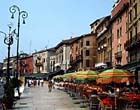 This piazza is one of the pleasantest places to meet friends for a drink before dinner; it was transformed into one of the most elegant ‘drawing-rooms’ of the city in the second half of the in the 18th c. It was then that the Listòn, Verona’s finest promenade, was created, and some of the existing residences were rebuilt. In fact, only the 18th c. neoclassical Palazzo della Gran Guardia Nuova and the building housing the Maffei Lapidary Museum are entirely new. The Palazzo della Gran Guardia and the Teatro Filarmonico were begun in the 17th c. but only completed two centuries later.
This piazza is one of the pleasantest places to meet friends for a drink before dinner; it was transformed into one of the most elegant ‘drawing-rooms’ of the city in the second half of the in the 18th c. It was then that the Listòn, Verona’s finest promenade, was created, and some of the existing residences were rebuilt. In fact, only the 18th c. neoclassical Palazzo della Gran Guardia Nuova and the building housing the Maffei Lapidary Museum are entirely new. The Palazzo della Gran Guardia and the Teatro Filarmonico were begun in the 17th c. but only completed two centuries later.
|
A TAVOLA |
|
| Gnocchi di San Zeno | Pearà |
| These are the famous gnocchi produced in Verona to celebrate Carnival time. Made according to family recipes of inhabitants of the San Zeno area, but on sale all year round in city centre delicatessen shops. The gnocchi dough is the classic one: floury potatoes, eggs, flour and salt. The dough is rolled out, cut in pieces and then boiled in salted water. The traditional sauce is melted butter and cheese, but the authentic Carnival dish involves the accompaniment of a rich horsemeat stew, a Veronese speciality. | The classic Pearà sauce can be found in Verona’s more traditional restaurants, usually served as an accompaniment to boiled meats (bollito misto). As the name suggests in Italian, pepper is the most important ingredient. The recipe explains the strong taste: toasted bread is crumbled up and then mixed with melted beef, veal and pork-bone marrow in a saucepan. The mixture is bound together with butter and gently cooked with carefully judged ladles of beef broth. Cook for at least one and a half hours on a low heat before flavouring with salt and handfuls of coarse-ground pepper. |
| Pandoro | |
| This is a traditional Christmas cake whose popularity has spread its use to celebrations throughout the year. Only professional patisserie shops, and industrial producers of course, can make it correctly. It must be well risen, extremely light, and served with a dusting of icing sugar | |
|
IL VINO |
| To the right of lake Garda, and to the north of the city of Verona, lies the region of the Veronese, subdivided into the smaller regions of Bardolino, Valpolicella, Soave and Gambellara. These last three zones are characterized by production of a wine that has recently been awarded the classification of D.O.C.G.: Recioto. The name is derived from the word "recia", which means "ear" in the local dialect, and indicates the part of the grape clusters that are the most exposed to the sun. These grapes, selected during the harvest, are sun-dried and made into wine, usually around December, and sometimes February, are the origin of a wine that can be sweet, or dry, depending on whether or not all the sugar in the grapes has been converted to alchohol. Out of all the dry Ricioto wines, the most distingushed is the Amarone: one of most reclaimed wines of the region, a deep rich color of bright cranberries, full bodied, velvety and warm, with a characteristic bouquet that hints of bitter almonds (hence its name: Amarone: the bitter one). If you would like to prepare a lunch or dinner reminiscent of the area, click here to purchase wines carefully selected by our experts. |
|
EATING AND SLEEPING |
| When in Verona we recommend you stop off at the Taverna di Via Stella (tel. +39 045-8008008), situated in the historical center very close to where Juliet’s terrace is. They propose local cuisine and an excellent wine list. Near Negrar, in the heart of Valpolicella, you can take advantage of a great quality price ratio at Alla Ruota restaurant, (tel. +39 045-7525605). There you can enjoy whole-wheat pappardelle (a kind of lasagna), but you can’t miss main dishes such as marinated rabbit. The wine list is also very good. If you wish to spend the night in Verona we recommend the Torcolo hotel (tel. +39 045-8007512) situated in a palace near the Arena. The rooms are very cozy and are furnished in different styles and there’s also the possibility to have breakfast on the terrace during the warm seasons. Outside Verona, in Ospedaletto di Pescantina, which is about 15 kilometers north-west, we recommend the Villa Quaranta hotel (tel. +39 045-6767300), which was obtained from a splendid XVII century villa and is surrounded by a park with a swimming pool and two tennis courts. The service is very well taken care of. |








